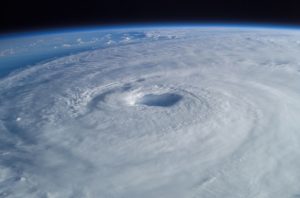
While Hurricane Dorian dissipated into the Atlantic Ocean, more storms are brewing in the Atlantic as the peak season for hurricanes kicked off September 10.
Dorian tore a path from the Bahamas, to the Carolinas, and up to the east coast to Nova Scotia. The storm hit the Bahamas as a Category 5 and caused widespread destruction [1].
According to CNN [2], hurricane season began on June 1 and is not officially over until November 30.
CNN reports that forecasts are watching the Atlantic and the formation of several storms. The report states there is a disturbance between Africa and the lesser Antilles that has a 20% chance of turning into a hurricane over the next 48 hours. Those chances increase to 30% over the next five days, according to the National Oceanic and Atmospheric Administration (NOAA). [3]
A second disturbance, located north of Hispaniola, while relatively calm now, has a 20% chance of turning into a hurricane as it approaches the northern Bahamas and Florida later this week.
Additionally, the NOAA stated that storm development in the Atlantic will ramp up in the coming weeks. Forecasters predict there is a 45% chance hurricane activity is above normal for the rest of the season.
On average, NOAA states an average of 12 named storms come out an Atlantic hurricane season. A storm gets a name with sustained winds of at least 39 mph.
NOAA predicts there would be 10-17 named storms this season, and five to nine of them would be hurricanes.
Meanwhile, many Fannie Mae servicers have taken steps to improve their engagement and communication with borrowers who may be caught in the path of storms this hurricane season, according to Mike Hernandez, VP of Housing Access and Disaster Response and Rebuild at Fannie Mae.
Hernandez says most servicers will send notifications to remind borrowers who their servicers even before a natural disaster has impacted a certain community.
“That’s tremendously helpful because you may not know if your servicer has changed. Just doing that in advance is tremendously helpful,” Hernandez said.
One of Fannie Mae’s innovative solutions to help borrowers is its Disaster Relief Extend Modification, which Hernandez characterized as one of its “most effective tools” for helping homeowners hurt by a natural disaster.
This loan modification was first introduced in late 2017 and reissued in February 2019. The program offers a temporary, up to 12-month post-disaster forbearance for borrowers.
“It's been a win-win for servicers. It's certainly been a win-win for our borrowers,” he said, noting that the cure rate for these loans is very high.
Hernandez adds that being prepared is crucial as storms are getting larger in size. And, he said his team takes a longer view when it comes to working with communities as the rebuild efforts in the wake of some of these larger storms can be prolonged.
Meanwhile, communities impacted by a natural disaster are often neighborhoods with a shortage of housing. So, a storm can impact the supply of affordable housing for renters and low income homeowners. As a result, supporting these neighborhoods in a time of need becomes even more of a priority for Fannie Mae, says Hernandez, noting that for him and his team the question always is: “How do we help that portion of the community come back as quickly as possible?”